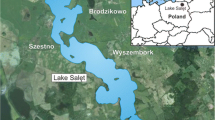Abstract
Palynological studies and investigations on macrofossil remains have been carried out on two profiles of the Holocene sediments of Lake Arkutino situated near to the Black Sea coast of SE Bulgaria. Lake Arkutino is a freshwater lake with shallow water. The lake is separated from the Black Sea by a dune barrier. Sedimentation started at about 6100 B.P. No marine or brackish influence could be traced in the sediments although the lake level is around sea level. The history of vegetation does not display major fluctuations except for the lake vegetation itself and for the swamp forests (Longos forests) surrounding the lake. Forests on normal mineral soils were mainly occupied by deciduous oaks throughout the last 6100 years. Deciduous oaks are represented in the pollen diagrams by the Quercus robur type and the Quercus cerris type. Until about 5800 B.P., one of the two pollen diagrams indicates that forests still contained more Pinus and Corylus than afterwards. After 5800 B.P., Fagus and a hundred years later together with Carpinus betulus became more important in addition with submediterranean elements as Carpinus orientalis, Fraxinus ornus and Phillyrea. After 5200 B.P., Carpinus betulus became somewhat less important. Indicators for human influence are rare. The archaeological record speaks for a small population in the area under study since the 12th century B.C. Swamp forests of the so-called Longos forests type started to develop at about 3000 B.P. The macrofossil record offers possibilities to trace hydrological changes by tracing the history of hydrophyte and reed plant comminties. From about 5100 to at least 4000 B.P., the record for Lemnetea and Potametea communities is poor and the processes of terrestrialization was interrupted. It can be assumed that the highest Black Sea transgression which is dated to 5700–4000 B.P. and which showed a sea level 3–4 m higher than today heavily influenced Lake Arkutino. That may have resulted in a higher lake level and in some water supply from the nearby river Ropotamo which would explain certain changes in the sediments and in the composition of hydrophyte communities.
Similar content being viewed by others
References
Beug H-J (1957) Untersuchungen zur spätglazialen und frühpostglazialen Floren- und Vegetationsgeschichte einiger Mittelgebirge (Fichtelgebirge, Harz und Rhön). Flora 145: 167–211
Beug H-J (1961) Beiträge zur postglazialen Floren- und Vegetationsgeschichte in Süddalrnatien: Der Sec „Malo Jezero“ auf MIjet. II Häufigkeit und Pollenmorphologie der nachgewiesenen Pflanzensippen. Flora 150: 632–656
Bondev I, Jordanov D (1973) Forestry Map. In: General Direction of Geodesy and Cartography (ed) National Atlas of the People's Republic of Bulgaria (in Bulgarian) Sofia p 90
Bozilova E, Ivanov I (1985) Paleoenvironment in the area of the Varna Lake during Eneolothic and Bronze Age on the basis of palynological, paleoethnobotanical and archaeological evidence (in Bulgarian). Bull Musee Nat Varna 21: 43–78
Bozilova E, Tonkov S (1985) Paleoecological studies in Lake Durankulac. Ann Univ Sofia Fac. Biologie 76 (2), Botanique: 25–30
Chepalyga A (1984) Inland sea basins. In: Wright and Barnosky (eds) Late Quaternary environments of the Soviet Union. Longman, London
Filipova M (1985) Palaeoecological investigations of Lake Shabla-Ezeretz in north-eastern Bulgaria. Ecol Mediterr 11: 147–158
Fol A, Spiridonov T (1983) Historische Geographie der thrakischen Stämme bis zum 3. Jh. v.u.Z (in Bulgarian). Verh Bulg Akad Wiss, Sofia
Horvat L, Glavac V, Ellenberg H (1974) Vegetation Südosteuropas. Fischer, Stuttgart
Jordanov D (1939) Die Vegetationsverhältnisse im bulgarischen Teil des Strandja-Gebirges (in Bulgarian). Ann Univ Sofia 34/35: 80–86
Kanev D (1960) Morphology of the Black Sea area (in Bulgarian). Annu Univ Sofia 76: 75–118
Kitanov B (1940) Some data about the fossil flora from the village Losenec near Sofia (in Bulgarian). Bulg Geol Soc 12: 1–28
Müller M (1980) Handbuch ausgewählter Klimastationen der Erde. 2nd edn. Trier.
Smit A (1973) A scanning electron microscopical study of the pollen morphology in the genus Quercus. Acta Bot Need 22: 655–665.
Walter H, Lieth H (1964) Klimadiagramm-Weltatlas. 2nd edn. Fischer, Jena.
Author information
Authors and Affiliations
Rights and permissions
About this article
Cite this article
Bozilova, E., Beug, HJ. On the holocene history of vegetation in SE Bulgaria (Lake Arkutino, Ropotamo region). Veget Hist Archaebot 1, 19–32 (1992). https://doi.org/10.1007/BF00190698
Received:
Accepted:
Issue Date:
DOI: https://doi.org/10.1007/BF00190698




